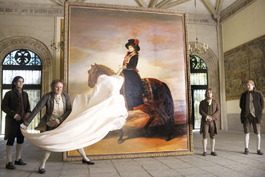home | metro silicon valley index | movies | current reviews | film review

Unveiled: Goya (Stellan Skarsgard) shows off his latest portrait with a flourish in 'Goya's Ghosts.'
Brush With Fate
Milos Forman's 'Goya's Ghosts'—because nobody expects the Spanish Inquisition
By Richard von Busack
THE STORY of Milos Forman's Goya's Ghosts is the story of an idea changing over the years, formless and finally molded by the pressure of current events. The original idea was something like a biopic with Javier Bardem playing the artist—how many people will show up to Goya's Ghosts wanting to see Bardem as Goya, only to discover that the placid Scandinavian Stellan Skarsgard nabbed the title role?
As it stands, the protagonist—there are no heroes—is actually a Madrid inquisitor of 1792, the falsely humble, simpering Brother Lorenzo (Bardem). With the permission of his superior (Michael Lonsdale, an ancient, rumbling hulk of an actor—the only real pleasure in this movie), Lorenzo reboots the Inquisition.
Informers track down a girl about town called Inés (Natalie Portman), who had a Jewish relative seven generations back. Observed refusing a dish of pork at an inn, she is arrested for secret Judaism and "put to the question": forced to confess, raped and left to rot in a dungeon.
The renowned artist Francisco Goya has been working on a portrait of Lorenzo, little knowing of the priest's evil. Goya was sweet on Inés, his model, and remains on good terms with her wealthy parents. He tries to intercede between them and Lorenzo, but the father decides to give Lorenzo a graphic lesson on the uselessness of forced confessions.
The cleric leaves Spain in disgrace. Goya washes his hands of the matter and goes back to work as a court painter of King Carlos and his straying queen. Fifteen years pass. When Napoleon's soldiers arrive—wreaking terror and rapine in ways familiar from viewings in Goya's engravings—they free the prisoners. This includes Inés, now a disfigured crone, left without family, except for the baby she had in jail.
While Inés wanders, crazed and seeking her child—now grown into a prostitute (also played by Portman and just as broadly), the movie observes the reversals of fortune in Lorenzo's life. Once an inquisitor, he now works as a well-paid agent of the Enlightenment; the old brutality is revealed in a glossy new form.
Except for the different way their stories ended, Lorenzo would seem to be based on Juan Antonio Llorente, who had been the general secretary of the Spanish Inquisition in the 1790s. Llorente was paid by King Joseph Bonaparte to write a history of the Inquisition. As historian Will Durant put it, Llorente "found it safer to do this in Paris, and in French." It was a prosecutorial book, claiming that 300,000 heretics were burned.
Catholic apologists counter that the figure was maybe only 3,000, apparently a much more reasonable figure by their lights. Llorente's history might well make Catholics feel more burned than burning; the book contributed to anti-papist hysteria in early America and also (according to researcher Margaret Alterton) fed Poe the idea for "The Pit and the Pendulum." Poe himself might have been interested in the gorehound side of Goya's Ghosts, which has lots of strappado and a foaming execution by the garrote. Although torture-porn abounds in current films, Forman might have offered an alternative. And what did Forman have in mind by making Goya so passive?
Forman and co-writer Jean-Claude Carrière have made Goya the least interesting person in the film. As he tries to connect Inés to her family, as he seems naively blind to the evil of Lorenzo, Goya becomes little more than a go-between—and a bit of a sucker. Goya himself turns into a ghost in this film, an apolitical, cautious creature drifting along in whatever way the power is flowing.
No one who sees Goya's real art during the end-titles—as opposed to the ill-painted replicas we see Skarsgard scrubbing away at—can believe the artist was nothing but the recorder of current events. The title captions in Caprichos or The Disasters of War can be icily calm: "This I saw" or "That always happens." That doesn't mean the pictures are uninflected. Goya may have been bloody, but he wasn't surgical.
It's the other way around in this sadistic movie, which sees the ebb and flow of power as a cruel unchangeable comedy. The decadent monarchy—led by King Randy Quaid, if you can believe it—is replaced by more vigorous and monstrous French usurpers. In a battle scene, Wellington arrives and scatters the French troops as if they were sheep; the general's cruel smile shows that Forman doesn't care for Wellington much, either. Goya's opinion of Wellington can be guessed from the end titles; note the thousand-yard stare in Goya's portrait of the duke. It is the same chilling exhaustion you can see in photos of soldiers in World War II.
Goya's Ghosts supplies more grounds for despair than fury. One understands Forman's mood; he is a man who lived through the Holocaust and the Soviet Occupation, and now he is deep in Bush and Cheney's epic misrule. Maybe Luis Buñuel, who seems to be one of the ghosts haunting this picture, could have found a better balance of sorrow and mirthless mirth.
What we see in Goya's Ghosts is a bilious yet stodgy fable of political upheaval, larded with references to Gitmo and the miserable Iraq war; and it ends in perfect nihilism, with a fascist and a whore hand in hand.
![]() Goya's Ghosts (R; 114 min.), directed by Milos Forman, written by Forman and Jean-Claude Carrière, photographed by Javier Aquirresarobe and starring Stellan Skarsgard, opens July 20.
Goya's Ghosts (R; 114 min.), directed by Milos Forman, written by Forman and Jean-Claude Carrière, photographed by Javier Aquirresarobe and starring Stellan Skarsgard, opens July 20.
Send a letter to the editor about this story.
|
|
|
|
|
|